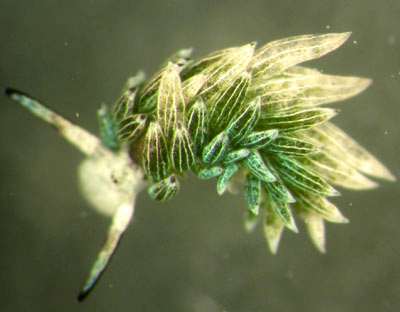
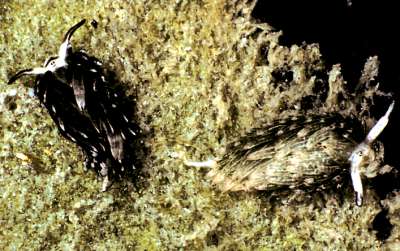
Costasiella usagi
Ichikawa, 1993
Order: SACOGLOSSA
Superfamily: LIMAPONTIOIDEA
Family: Costasiellidae
DISTRIBUTION
Tropical western pacific
PHOTO
Upper: On sandy bottom at 16-18m, Watsons Bay, Lizard Island, QLD, Australia, late December 2003. 3-5mm long. Photo: Nils Anthes
Lower: Photo showing two extreme colour variations together on their food algae Avrainvilla. 4.5mm (dark form), 6.0mm (light form); Cocos Lagoon, Guam. 25 January 1989. Photo: C. Caelson & P.J. Hoff.
From Carlson & Hoff's messages Costasiella usagi is very variable in colour. In Ichikawa's description the colour is described as:
"The head and tail are not pigmented,, and the rhinophores are black. The median cerata are grey, while the outer ones are black. All the cerata possess a white end and a black tip. Moreover, all the cerata bearl longitudinal striations reaching from the base of each ceras to the white apical portion. ... The ventral side of the foot is white. .... Smaller specimens have the median cerata coloured green, instead of grey."
Ichikawa doesn't say what colour the longitudinal striations are but apparently they are white. From photos on the Forum, the rhinophores range from completely black to black edged, and in some specimens green can be the predominate colour in all cerata. This is certainly a good example of the dangers of describing new species prematurely.
References:
Ichikawa, M. (1993) Saccoglossa Opisthobranchia) from the Ryukyu Islands. Publications of the Seto Marine Biological Laboratory, 36: 119-139.
Rudman, W.B., 2004 (January 9) Costasiella usagi Ichikawa, 1993. [In] Sea Slug Forum. Australian Museum, Sydney. Available from http://www.seaslugforum.net/find/costusag
Related messages
Colour variation in Costasiella usagi [1]
January 15, 2004
From: C. Carlson & P. Hoff

Bill,
Following our last message I am sending a few photos of Costasiella usagi showing colour variation. None really tell
the whole picture, but together they may make some sense. In this message is a photo of two animals on their food algae Avrainvilla. There are further variations in a second message
Upper photo shows the two together.
4.5mm (dark form), 6.0mm (light form); Cocos Lagoon, Guam. 25 January 1989. On Avrainvilla
Clay & Patty Jo
ccarlson@kuentos.guam.net
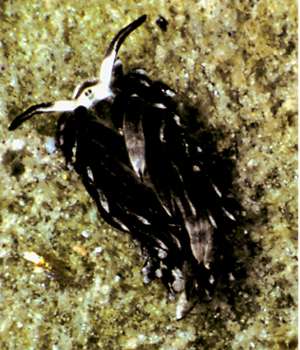
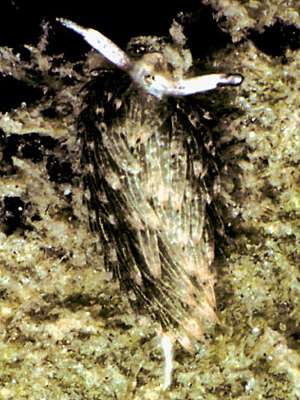
Dear Clay & Patty Jo,
Thanks very much for the photos in both your messages. When we compare the animals in your photos with the one in Nils Anthes message it shows how dangerous it is to describe new species from very few animals.
Best wishes
Bill Rudman
Colour variation in Costasiella usagi [2]
January 15, 2004
From: C. Carlson & P. Hoff
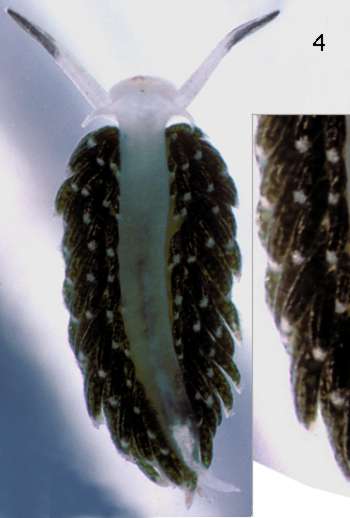
Bill,
To accompany our other message here are some more photos showing variation in Costasiella usagi.
[4] Guam, Cocos reef, 15 May 1989. 6 mm long.
[6] Guam, Bile Bay, 14m; 15 July 1981. 5.5 mm long.
[7] Pohnpei, Nan Madol, shallow channel; 1 July 1973. 7 mm long.
Clay & Patty Jo
ccarlson@kuentos.guam.net

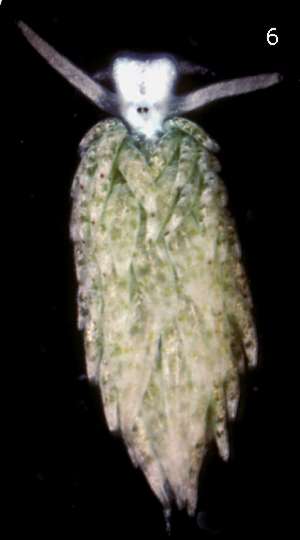
Thanks Clay & Patty Jo
Bill Rudman
Costasiella sp. 4 is C. usagi
January 12, 2004
From: Clay & Patty Jo
Bill,
Concerning the animal in Nils' message. The longitudinal lines & dark upper half of the rhinophores I believe are typical of Costasiella usagi Ichikawa, 1993. Some of our specimens are found with a gray mask on the lower half of the head.
Clay
ccarlson@kuentos.guam.net
Carlson, C. & Hoff, P., 2004 (Jan 12) Costasiella sp. 4 is C. usagi. [Message in] Sea Slug Forum. Australian Museum, Sydney. Available from http://www.seaslugforum.net/find/11877Thanks Clay & Patty-Jo,
I'm afraid I looked at Ichikawa's paper but after looking at her illustration of this species, which shows totally black rhinophores and no sign of longitudinal lines, I didn't dwell on her description. Species of Costasiella obviously show considerable colour variation which makes our interpretation of Ichikawa's descriptions quite difficult since they are often based on very few animals. Until we have a better understanding of intraspecific variability it is going to be difficult to identify her species.
Costasiella usagi is a good example. In Ichikawa's description the colour is described as:
"The head and tail are not pigmented,, and the rhinophores are black. The median cerata are grey, while the outer ones are black. All the cerata possess a white end and a black tip. Moreover, all the cerata bearl longitudinal striations reaching from the base of each ceras to the white apical portion. ... The ventral side of the foot is white. .... Smaller specimens have the median cerata coloured green, instead of grey."
Ichikawa doesn't say what colour the longitudinal striations are. I am happy to accept you view that they are white, and if you look carefully at Nil's photo a few of the larger anterior cerata seem to have some black pigmentation. This is certainly a good example of the dangers of describing new species prematurely. If you have photos of this species showing colour variants they would be a welcome addition.
Best wishes
Bill Rudman
Costasiella sp. 4 from Lizard Island, Qld.
January 10, 2004
From: Nils Anthes

Dear Bill,
Here is a picture of a small Aeolid (ca. 3-5mm) that we found in hundreds on sandy bottoms at 16-18m depths at Watsons Bay (Lizard Island, QLD, Australia) in late December 2003. They seem to feed on the algae where we mostly found them.
Best wishes
Nils Anthes
anthes@uni-muenster.de
Anthes, N., 2004 (Jan 10) Costasiella sp. 4 from Lizard Island, Qld.. [Message in] Sea Slug Forum. Australian Museum, Sydney. Available from http://www.seaslugforum.net/find/11833Dear Nils,
This is a sacoglossan rather than an aeolid, and from the position of the eyes - close together in the middle of the head - it is a species of Costasiella. I don't know a species with a pattern of white lines on the cerata like this, but if it is named this colour pattern will be instantly identifiable
Best wishes
Bill Rudman
